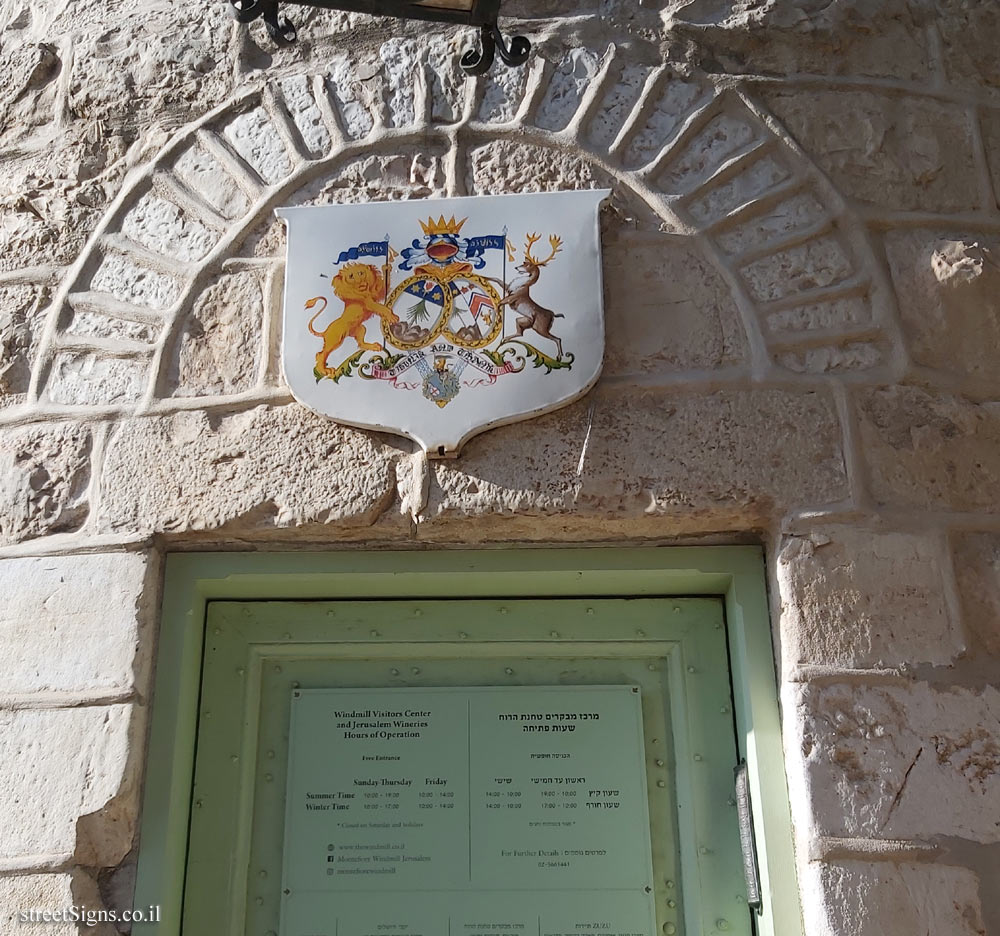On the sign:
טחנת הרוח מונטיפיורי
בשנת 1855 ערך השר מונטיפירי נדבן יהודי מאנגליה. את המסע הרביעי לארץ ישראל, בירושלים רכש קרקע מחוץ לחומות העיר העתיקה מכספי עזבונו של יהודה טורו מניו אורלינס (ארה"ב), תחם אותה בחומת אבנים וקרא לה על שמו ועל שם רעייתו "כרם משה ויהודית".
בשטח שנרכש הוקמה טחנת הרוח (1857) ונוסדו השכונות משכנות שאננים (1860) וימין משה (1892). הטחנה נבנתה על-ידי תומס ריצ’רד הולמן, מומחה להקמת טחנות רוח מקנטרברי שבאנגליה. במשך שמונה עשרה שנים סיפקה הטחנה החדשה פרנסה למפעיליה וקמח מוזל לאוכלוסייה הגדלה של יהודי העיר. בשנת 1876 הופסק השימוש בטחנה בשל עלויות אחזקה גבוהות ובשל הפעלתן של טחנות קמח חדשות בעיר שפעלו באמצעות כח הקיטור הזול יותר.
במרוצת השנים, מבנה הטחנה נזנח ועמד בשיממונו. במלחמת השחרור התקינה "ההגנה" עמדת תצפית בקצה המגדל (מרץ תש"ח). כעבור שבועות אחרים, הבחינו הבריטים בנעשה והורו לפוצצה. לימים, בניין הטחנה הפך לאחד מסמליה הבולטים של ירושלים ומצוי בתחום גן לאומי סובב חומות העיר העתיקה.
בשנת 2012, סיימה הקרן לירושלים את השיחזור המלא של הטחנה בסיוע משרד ראש הממשלה. משרד התיירות, עיריית ירושלים ובתרומתה של אגודת "נוצרים למען ישראל", הולנד. כעבור שנה נטחן שק הקמח הראשון, לאחר הפסקה בת 137 שנים.
בשנת 2017 יזמה הקרן לירושלים בשיתוף הרשות לפיתוח ירושלים, משרד ירושלים ומורשת ועיריית ירושלים הקמה של מרכז מבקרים בטחנת הרוח, מרכז המבקרים מופעל על ידי חברת זוזו תיירות בע"מ.
נכחב ע"י פרופ’ שאול ספיר
Montefiore Windmill
In 1855, the Jewish British philanthropist Sir Moses Montefiore embarked on the fourth of his seven journeys to Palestine, then part of the Ottoman Empire. With funds from the estate of Judah Touro of New Orleans, Sir Moses purchased a plot of land outside Jerusalem’s city walls, fortified it with a stone wall and named it Kerem Moshe VeYehudit (the Vineyard of Moses and Judith), after himself and his wife.
That plot of land was to become the site of the windmill (1857), the Mishkenot Sha’ananim neighborhood (1860) and the Yemin Moshe neighborhood (1892). The windmill was constructed by millwright Thomas Richard Holman of Canterbury in the district of Kent, England. For 18 years, Montefiore’s windmill. provided employment to its operators and low-cost flour to the growing Jewish community in Jerusalem. In 1876, the windmill ceased to operate due to high maintenance costs and new technology that powered windmills with lower-cost steam power.
Over the years, Montefiore’s windmill stood as a neglected, yet picturesque, symbol and landmark of Jerusalem. During Israel’s War of Independence, the Haganah, the main Jewish defense force at that time, built a military post on the tower’s roof (March 1948). A few weeks later, the British noticed the addition and ordered the tower blown up.
For years to come, the windmill became one of the most prominent symbols of Jerusalem located in, the "surrounding walls of the Old City National Park".
In 2012, the Jerusalem Foundation completed the full restoration of Montefiore’s windmill with the support of Christians for Israel, Holland, the Prime Minister’s Office, the Ministry of Tourism and the Jerusalem Municipality. The following year witnessed the production of the windmill’s first sack of flour after a break of 137 years.
In 2017, the Jerusalem Foundation, the Jerusalem Development Authority, the Ministry of Jerusalem and Heritage and the Jerusalem Municipality collaborated on the establishment of the windmill visitors center. The center is operated, by Zuzu - Tourism company.
Written by Prof. Shaul Sapir
סמל מיתוג של העיר ירושלים / סמל הרשות לפיתוח ירושלים / סמל משרד ירושלים ומורשת / סמל רשות הטבע והגנים / סמל הקרן לירושלים
Branding emblem of the city of Jerusalem / Emblem of the Jerusalem Development Authority / Emblem of the Ministry of Jerusalem and Heritage / Emblem of the Nature and Parks Authority / Emblem of the Jerusalem Foundation

 Click for a larger image
Click for a larger image  Click for a larger image
Click for a larger image  Click for a larger image
Click for a larger image